Lancaster, Pennsylvania – Wednesday, June 11th, 2008
 Having completed a morning marathon on New Jersey’s Hellcat and a two hour drive past the Philadelphia skyline, my dad and I arrived in the parking lot of Dutch Wonderland in Lancaster, Pennsylvania by 2:00pm that afternoon. I was slightly taken aback when I discovered the Hershey-owned park was not as removed in Amish country as I had been anticipating but was in fact along a fairly commercialized stretch of the Lincoln Highway, the parking lot with the large square castle entrance in the background making it appear
Having completed a morning marathon on New Jersey’s Hellcat and a two hour drive past the Philadelphia skyline, my dad and I arrived in the parking lot of Dutch Wonderland in Lancaster, Pennsylvania by 2:00pm that afternoon. I was slightly taken aback when I discovered the Hershey-owned park was not as removed in Amish country as I had been anticipating but was in fact along a fairly commercialized stretch of the Lincoln Highway, the parking lot with the large square castle entrance in the background making it appear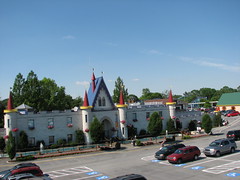 more strip mall than amusement park; the blue and purple framework of the Kingdom Coaster spied around the back corner confirming that we had indeed arrived at our destination. Like Clementon that morning I was here primarily for a single wooden coaster, although I maintained a strong belief that more – actually, any – small park pleasures would be found once the coaster was ticked off the list. Since they offered a discounted combined ticket with Hersheypark my dad would be joining me for the next couple
more strip mall than amusement park; the blue and purple framework of the Kingdom Coaster spied around the back corner confirming that we had indeed arrived at our destination. Like Clementon that morning I was here primarily for a single wooden coaster, although I maintained a strong belief that more – actually, any – small park pleasures would be found once the coaster was ticked off the list. Since they offered a discounted combined ticket with Hersheypark my dad would be joining me for the next couple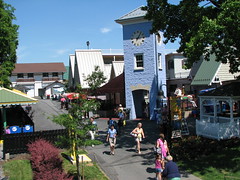 of hours before continuing on to make that our third and final park of the day for their free ‘preview’ night deal (it required a bit of double-checking at the gate to make sure that, yes, we were allowed to access the preview night with this ticket).
of hours before continuing on to make that our third and final park of the day for their free ‘preview’ night deal (it required a bit of double-checking at the gate to make sure that, yes, we were allowed to access the preview night with this ticket).
I was more than pleased to discover that once we got through the castle, the concrete strip mall aesthetic the park originally suggested completely vanished and we found ourselves confronted with a thoroughly pleasant, green landscape. Numerous walkways meandered between trees, gardens and the occasional family ride, some with the sole intent of just to meander, with no midway measuring wider than what a single lane of economy cars would be capable of navigating while even allowing some topographical changes. No, its newness lacked the same charm and quirk of some of Pennsylvania’s other fine historical parks, but it was clean and well looked after, a trait that honestly was all we could ask for after four parks in New Jersey. I regret that our ambitions were singularly focused on the roller coasters as it seemed to offer many possibilities sure to please a younger audience or the young at heart if one had the will and time to make a longer day of it.
and quirk of some of Pennsylvania’s other fine historical parks, but it was clean and well looked after, a trait that honestly was all we could ask for after four parks in New Jersey. I regret that our ambitions were singularly focused on the roller coasters as it seemed to offer many possibilities sure to please a younger audience or the young at heart if one had the will and time to make a longer day of it.
We took the Sky Ride chairlift over the grounds to the far opposite side of the park where most of the bigger rides have been constructed. This honestly was far slower than walking but it made for a great way to see the park and to watch from overhead a couple of in-progress children’s theater shows, one involving green frog-men diving into a pool. Whatever passes for entertainment in Lancaster, I guess…
The lift deposited us directly across from our first ride, the Joust, a Chance Rides Big Dipper kiddy coaster identical to the one installed in my home park of Michigan’s Adventure… a coaster that I rode exactly once when it first opened in 1999 and have never repeated again in the decade since. To the outside observer it may appear beguiling as to why we would need to travel several states away to ride something we never even bother with when it’s in our own backyard, but that’s clearly missing the point of it. The point was somewhat lost on the operator as well, who had a good time warning us that this compared favorably to many extreme thrill rides across the country. Yeah, it was kind of lame and with bad pre-banking technique, but at least we can say we did it.
it’s in our own backyard, but that’s clearly missing the point of it. The point was somewhat lost on the operator as well, who had a good time warning us that this compared favorably to many extreme thrill rides across the country. Yeah, it was kind of lame and with bad pre-banking technique, but at least we can say we did it.
 Kingdom Coaster, despite standing only 55 feet tall, was for me a landmark coaster. No, by itself it wasn’t much, but having opened in 1992 this was the first roller coaster built by Custom Coasters International, and I think could be argued was therefore the first postmodern wooden coaster that started the trend of economy, artistry, and innovation that has continued to this day by Great Coasters and Gravity Group. Wildcat and Hades, while both undeniably better coasters, in retrospect don’t have quite the same sense that they mark a truly historical benchmark as everything in those rides was already experimented with by the designers at Custom Coasters (Heide Park’s Colossos might have the makings of being another significant benchmark). However small or subtle, there was a paradigm shift with the Sky Princess that has continuously evolved to this day.
Kingdom Coaster, despite standing only 55 feet tall, was for me a landmark coaster. No, by itself it wasn’t much, but having opened in 1992 this was the first roller coaster built by Custom Coasters International, and I think could be argued was therefore the first postmodern wooden coaster that started the trend of economy, artistry, and innovation that has continued to this day by Great Coasters and Gravity Group. Wildcat and Hades, while both undeniably better coasters, in retrospect don’t have quite the same sense that they mark a truly historical benchmark as everything in those rides was already experimented with by the designers at Custom Coasters (Heide Park’s Colossos might have the makings of being another significant benchmark). However small or subtle, there was a paradigm shift with the Sky Princess that has continuously evolved to this day.
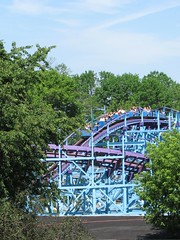 The ‘modern’ wooden coasters of Allen, Cobb, Dinn, et al, that preceded the Sky Princess did share many similar qualities, but the sense I get is that before Mike Boodley wooden coasters were designed from the ground looking up: a single, still-life sculpture to be viewed in whole, resulting in large, visually impressive structures that seem to represent a pursuit of the ideal wooden coaster form. Sky Princess had a small, lightweight structure with freeform curves and drops suggested a ride that was designed from the lead car: a kinetic expression of time and movement emphasizing the individual’s subjective experience of the moment. This trend continued
The ‘modern’ wooden coasters of Allen, Cobb, Dinn, et al, that preceded the Sky Princess did share many similar qualities, but the sense I get is that before Mike Boodley wooden coasters were designed from the ground looking up: a single, still-life sculpture to be viewed in whole, resulting in large, visually impressive structures that seem to represent a pursuit of the ideal wooden coaster form. Sky Princess had a small, lightweight structure with freeform curves and drops suggested a ride that was designed from the lead car: a kinetic expression of time and movement emphasizing the individual’s subjective experience of the moment. This trend continued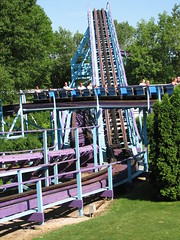 through the next two decades as the certainty of visual formation (flowing, layered curves and parabolic hills) gave way to the uncertain ‘ugliness’ of designs meant to confound and challenge the rider; especially true of the agro terrain wooden coasters which aren’t intended to be seen whole.
through the next two decades as the certainty of visual formation (flowing, layered curves and parabolic hills) gave way to the uncertain ‘ugliness’ of designs meant to confound and challenge the rider; especially true of the agro terrain wooden coasters which aren’t intended to be seen whole.
I doubt I ever would have interpreted this from the Kingdom Coaster had I not been looking closely at its historical footprint, as apart from the unique color scheme it’s otherwise extraordinarily unassuming (and I wish it were still the Sky Princess as femininity is increasingly rare in theme park design, plus it’s just a boring, unspecific name). Nevertheless, it’s still rather difficult to figure out exactly what the coaster is going to be like before climbing into the front seat. Is this a tame family coaster, or are they throwing some unexpected twists at us as well?
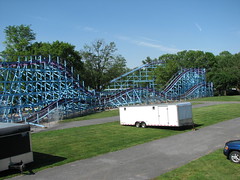 For its size the layout is surprisingly surprising, and I must imagine how it was viewed in 1992 when figure-eight layouts with flat elevated turnarounds were still the norm. From the lift there’s a swooping 90° turn that’s large enough that when you get to the main straight drop, you can almost think of it as a double-dip. This is followed by blink-and-you’ll-miss-it bunny hop and left shimmy, and then a much larger hill with a curving, dipped plateau at the top, a very unconventional opener for a time when hills were evenly space and generally progressed from largest to smallest in logical fashion. At the far end of the layout is a traditional fan curve, a rarity for CCI who later showed a perhaps excessive preference for swooping double-cresting turnarounds. The return run is an odd collection of unbanked, ground-level curve
For its size the layout is surprisingly surprising, and I must imagine how it was viewed in 1992 when figure-eight layouts with flat elevated turnarounds were still the norm. From the lift there’s a swooping 90° turn that’s large enough that when you get to the main straight drop, you can almost think of it as a double-dip. This is followed by blink-and-you’ll-miss-it bunny hop and left shimmy, and then a much larger hill with a curving, dipped plateau at the top, a very unconventional opener for a time when hills were evenly space and generally progressed from largest to smallest in logical fashion. At the far end of the layout is a traditional fan curve, a rarity for CCI who later showed a perhaps excessive preference for swooping double-cresting turnarounds. The return run is an odd collection of unbanked, ground-level curve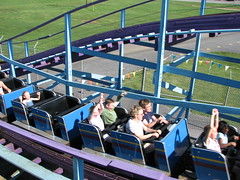 through a tunnel, some more bunny hops with curves, and another particularly brutal curve around the outside of the first drop, in which a lack of banking produces significant lateral G’s. There’s a bit of airtime on the last bunny hop (negative-G’s are still conservative here, and possibly the coaster’s weakest point), and then a fast, relatively high-banked 270° uphill helix crossing over the base of the lift and sending us into the brake run. All in all perhaps my favorite of the junior wooden coaster genre, and an all too often overlooked gem that deserves more recognition if not just for historical reasons.
through a tunnel, some more bunny hops with curves, and another particularly brutal curve around the outside of the first drop, in which a lack of banking produces significant lateral G’s. There’s a bit of airtime on the last bunny hop (negative-G’s are still conservative here, and possibly the coaster’s weakest point), and then a fast, relatively high-banked 270° uphill helix crossing over the base of the lift and sending us into the brake run. All in all perhaps my favorite of the junior wooden coaster genre, and an all too often overlooked gem that deserves more recognition if not just for historical reasons.
Our presence in a children’s park must have made us look conspicuously like coaster enthusiast, as a fellow of a similar persuasion spotted us on our way down the exit after a couple of rides to share in a nice conversation. It indeed was a nice conversation, for the first few minutes, but it soon became clear that even if I were to stop contributing anything to it, it had the potential to run on in monologue form for the better part of an hour that we didn’t have. Somewhere in there the topic of Six Flags Great America came up as we were told what all the good rides were, where I casually interjected that I was quite familiar with the park and was very certain the best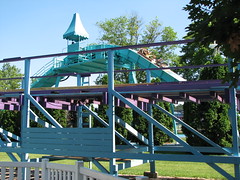 roller coaster there was the Iron Wolf (which I will maintain in all honesty is not far from the truth). The conversation ended rather quickly after that; we bid adieu and happy riding, my dad and I continuing on to take the Capital BlueCross Monorail, a single-station ride around the park, closely through the Kingdom Coaster structure, then out around the parking lot before returning. There was also the Double Splash Flume nearby which I honestly can’t remember if we rode or not. Either we passed it because it didn’t appear very memorable, or we did and it wasn’t very memorable. You get the idea.
roller coaster there was the Iron Wolf (which I will maintain in all honesty is not far from the truth). The conversation ended rather quickly after that; we bid adieu and happy riding, my dad and I continuing on to take the Capital BlueCross Monorail, a single-station ride around the park, closely through the Kingdom Coaster structure, then out around the parking lot before returning. There was also the Double Splash Flume nearby which I honestly can’t remember if we rode or not. Either we passed it because it didn’t appear very memorable, or we did and it wasn’t very memorable. You get the idea.
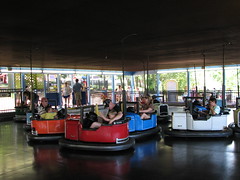 The last ride I ended up actually trying was Dutch Wonderland’s Bumper Cars, which I did mostly because I was told by a friend who had interned at Premier Rides to say ‘hi’ to the operator who also previously worked there. It turned out to be a good decision to ride anyway, as the cars were made by Lusse: smaller versions than at Knoebels that somewhat resembled the style of a Model T, but with enough power behind them to get some good bumping action. After this it was time to say farewell to Dutch Wonderland, sadly before exploring every other corner, missing a few worthwhile attractions such as a haunted swing and indoor boat dark ride, but we needed to leave enough time for dinner after the 45 minute drive to Hershey before starting the 7:30pm preview night.
The last ride I ended up actually trying was Dutch Wonderland’s Bumper Cars, which I did mostly because I was told by a friend who had interned at Premier Rides to say ‘hi’ to the operator who also previously worked there. It turned out to be a good decision to ride anyway, as the cars were made by Lusse: smaller versions than at Knoebels that somewhat resembled the style of a Model T, but with enough power behind them to get some good bumping action. After this it was time to say farewell to Dutch Wonderland, sadly before exploring every other corner, missing a few worthwhile attractions such as a haunted swing and indoor boat dark ride, but we needed to leave enough time for dinner after the 45 minute drive to Hershey before starting the 7:30pm preview night.
Comments